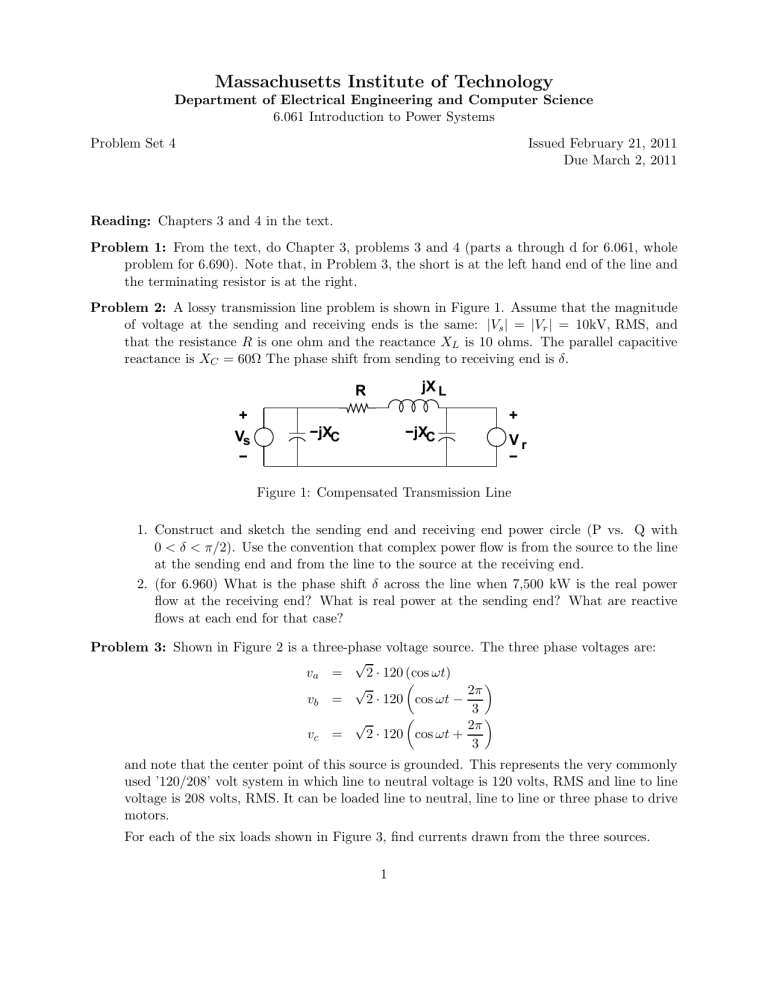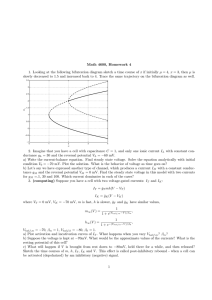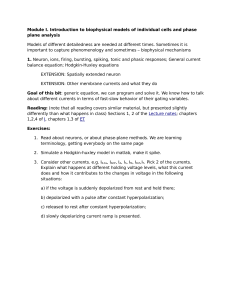Massachusetts Institute of Technology

Problem Set 4
Massachusetts Institute of Technology
Department of Electrical Engineering and Computer Science
6.061 Introduction to Power Systems
Issued February 21, 2011
Due March 2, 2011
Reading: Chapters 3 and 4 in the text.
Problem 1: From the text, do Chapter 3, problems 3 and 4 (parts a through d for 6.061, whole problem for 6.690). Note that, in Problem 3, the short is at the left hand end of the line and the terminating resistor is at the right.
Problem 2: A lossy transmission line problem is shown in Figure 1. Assume that the magnitude of voltage at the sending and receiving ends is the same: | | = V r that the resistance R is one ohm and the reactance X
L
= 10kV, RMS, and is 10 ohms. The parallel capacitive reactance is X
C
= 60Ω The phase shift from sending to receiving end is δ .
R jX
L
+
−
−jX
C
−jX
C
+
V
−
r
Figure 1: Compensated Transmission Line
1. Construct and sketch the sending end and receiving end power circle (P vs. Q with
0 < δ < π/ 2). Use the convention that complex power flow is from the source to the line at the sending end and from the line to the source at the receiving end.
2. (for 6.960) What is the phase shift δ across the line when 7,500 kW is the real power flow at the receiving end? What is real power at the sending end? What are reactive flows at each end for that case?
Problem 3: Shown in Figure 2 is a three-phase voltage source. The three phase voltages are:
√ v a v b
=
=
√
2 120 (cos
·
�
ωt
ωt
)
−
2
3
π � v c
=
√
·
� cos ωt +
2
3
π � and note that the center point of this source is grounded. This represents the very commonly used ’120/208’ volt system in which line to neutral voltage is 120 volts, RMS and line to line voltage is 208 volts, RMS. It can be loaded line to neutral, line to line or three phase to drive motors.
For each of the six loads shown in Figure 3, find currents drawn from the three sources.
1
A
+ v a
−
+ v c
−
C
− v b
+
B
Figure 2: Three-Phase Voltage Source
A A
120
Ω
C
120
Ω
120
Load A
B
Ω
A
120
Ω
120
Ω
C
Load B
120
Ω
B
360
Ω
A
360
Ω 360
Ω
C
A
360
Ω
B
360
Ω
Load C
B
A
120
Ω
120
Ω
B
C
360
Ω
Load D
B
Load E Load F
Figure 3: Resistive loads for Problem 3
Problem 4: The situation is as shown in Figure 4. A three phase current source is feeding a three phase resistive load. The currents are actually square waves, as shown in Figure 5. Assume the amplitude of the currents is 100 A and that each of the load resistances in Figure 4 is
10Ω. The ground resistance is of the four voltages: v a
, v b
, v c
, v g
R
. g
= 50Ω. Estimate and draw a dimensioned sketch of each
Problem 5: For 6.690
A three-phase ungrounded voltage source is shown in Figure 6 It is con nected to an unbalanced wye connected load consisting of two 1 Ω resistors and one 2 Ω resistor, as shown. Assume the voltage source is a balanced three phase 120/208 volt source as shown in Figure 2 above.
1. Find the three lead currents and draw a phasor diagram.
2. What is the voltage between the neutral of the wye connected resistors and then neutral of the voltage source?
2
i a
− v g +
+ v c
−
+ v
− a
− v b i b i c
Figure 4: Current Source Feeding Resistive Load i a i b i c
π
3
Figure 5: Currents
ω t
+ v a
−
+ v c
−
− v b
2
1
Figure 6: Voltage Source and Load
1
3
MIT OpenCourseWare http://ocw.mit.edu
6.061 / 6.690 Introduction to Electric Power Systems
Spring 2011
For information about citing these materials or our Terms of Use, visit: http://ocw.mit.edu/terms .







